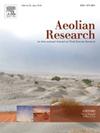阿根廷中部半干旱区沉积沉积物中草甘膦和AMPA的野外测量
IF 3.4
3区 地球科学
Q2 GEOGRAPHY, PHYSICAL
引用次数: 0
摘要
在阿根廷中部半干旱地区(CSRA),农业土壤与残存的原始森林共存。草甘膦用于农业土壤,但在CSRA中尚未评估降尘中草甘膦及其主要代谢物(氨甲基膦酸,AMPA)的存在。对2021年在森林斑块(FR)和周围农业土壤(AG)收集的沉积物中草甘膦和AMPA的存在和浓度进行了评估。FR和AG沉积物样品中均检测到草甘膦和AMPA。沉积物中草甘膦浓度在16.8 ~ 192.7 μ kg−1之间,AMPA浓度在31.9 ~ 210.3 μ kg−1之间。AG上沉积的草甘膦和AMPA浓度高于FR上沉积的草甘膦和AMPA浓度。草甘膦和AMPA浓度最高的季节是春季和初夏,此时草甘膦用于杂草防治,风蚀风险较高。我们的研究结果表明,风蚀、农村交通和耕作产生的沉积物可能是草甘膦和AMPA进入未使用除草剂的生态系统和地区的途径。本文章由计算机程序翻译,如有差异,请以英文原文为准。
Field measurement of glyphosate and AMPA in the deposited sediment on the central-semiarid region of Argentina
In the central semiarid region of Argentina (CSRA), agricultural soils coexist with remaining patches of native forest. Glyphosate is used on agricultural soils, but the presence of glyphosate and its main metabolite (aminomethylphosphonic acid, AMPA) in fallen dust have not been evaluated in the CSRA. The presence and concentration of glyphosate and AMPA were evaluated in the sediment collected in a forest patch (FR) and on a surrounding agricultural soil (AG) during 2021. Glyphosate and AMPA were detected in all samples of sediments on FR and AG. The concentration of glyphosate in the sediment ranged from 16.8 to 192.7 μg kg−1 and the concentration of AMPA ranged from 31.9 to 210.3 μg kg−1. Sediment deposited on AG showed a higher concentration of glyphosate and AMPA than that deposited on FR. The highest concentrations of glyphosate and AMPA were found in the second semester of the year (spring and early summer), when glyphosate is used intensively for weed control and wind erosion risk is higher. Our results show that the sediment generated by wind erosion, rural traffic and tillage could be a route for glyphosate and AMPA to enter into ecosystems and areas where the herbicide is not used.
求助全文
通过发布文献求助,成功后即可免费获取论文全文。
去求助
来源期刊

Aeolian Research
GEOGRAPHY, PHYSICAL-
CiteScore
7.10
自引率
6.10%
发文量
43
审稿时长
>12 weeks
期刊介绍:
The scope of Aeolian Research includes the following topics:
• Fundamental Aeolian processes, including sand and dust entrainment, transport and deposition of sediment
• Modeling and field studies of Aeolian processes
• Instrumentation/measurement in the field and lab
• Practical applications including environmental impacts and erosion control
• Aeolian landforms, geomorphology and paleoenvironments
• Dust-atmosphere/cloud interactions.
 求助内容:
求助内容: 应助结果提醒方式:
应助结果提醒方式:


